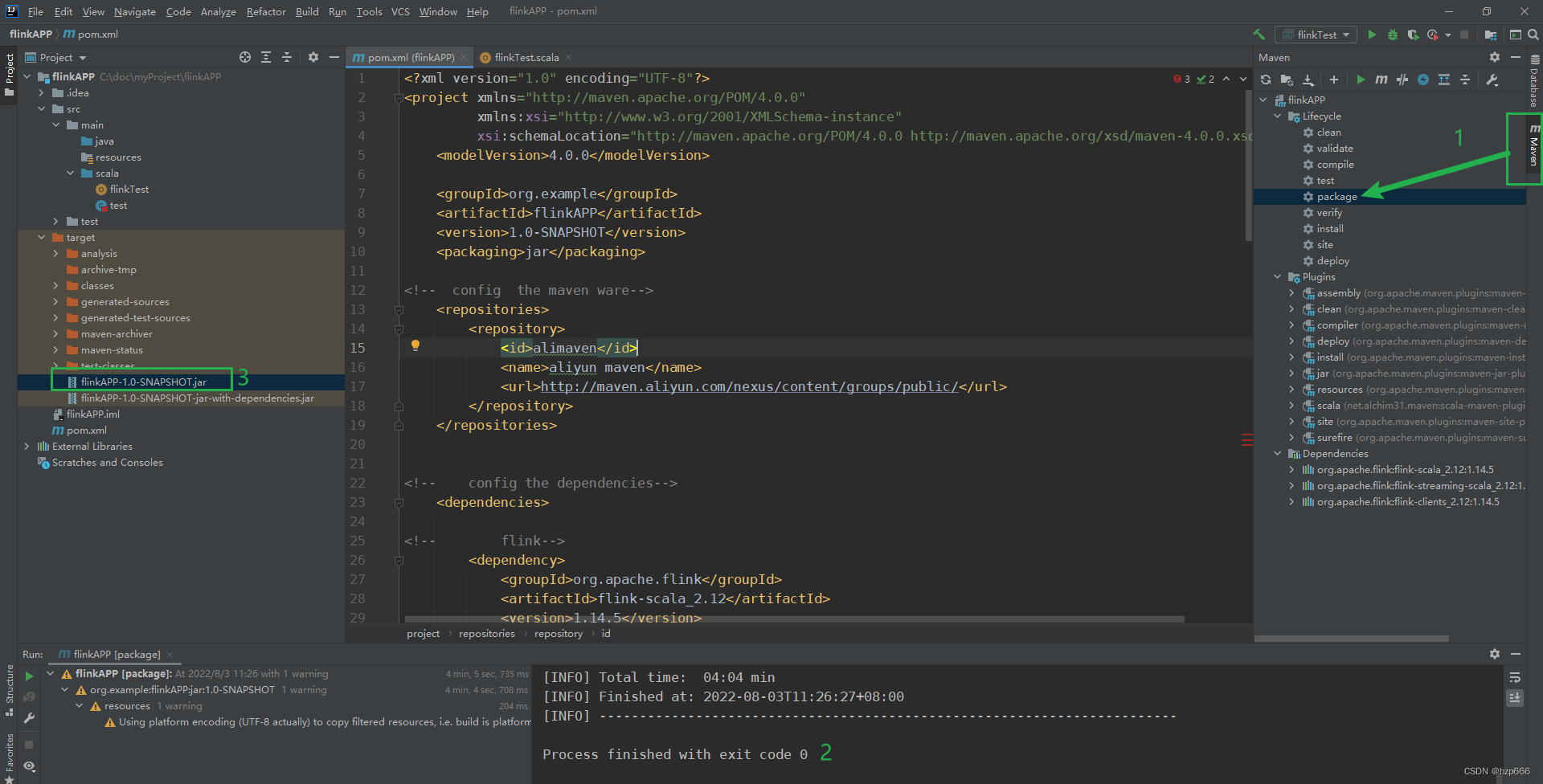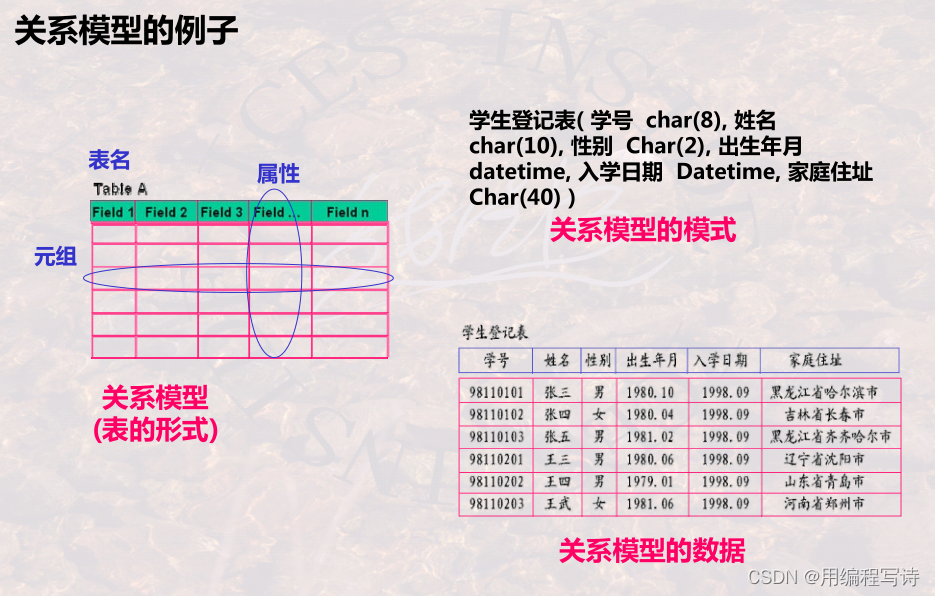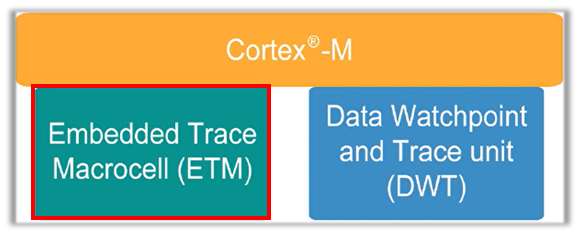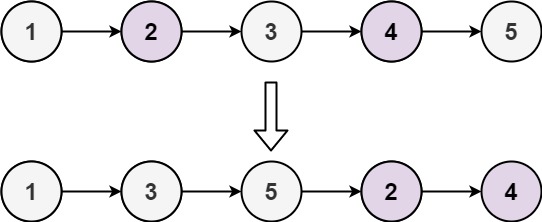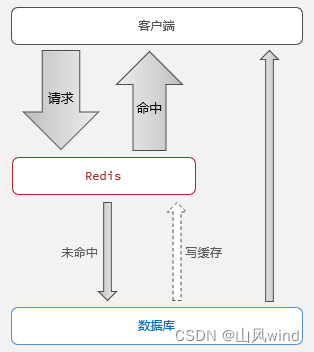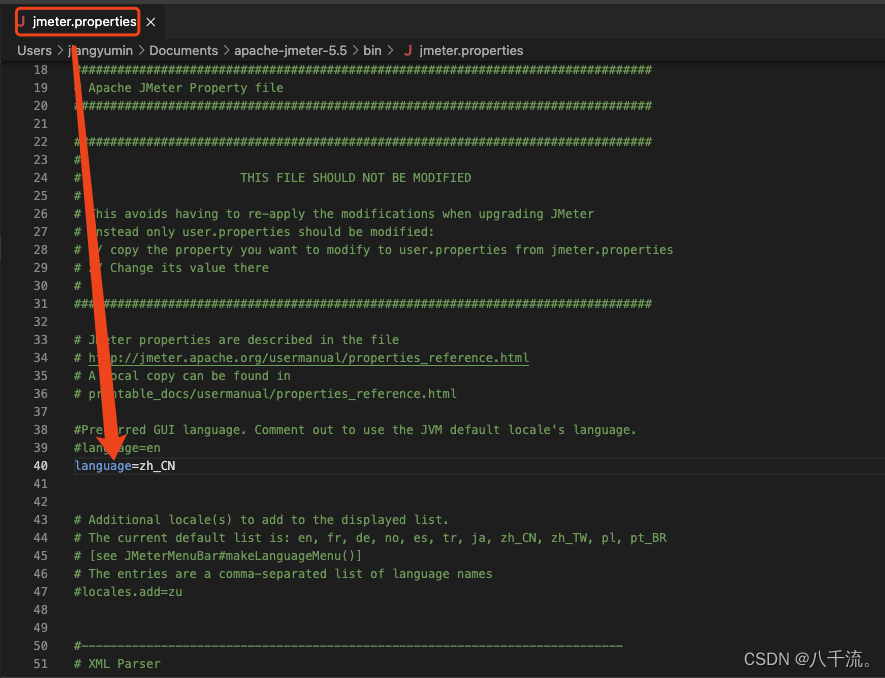当前位置:网站首页>[Structure internal power practice] Structure memory alignment (1)
[Structure internal power practice] Structure memory alignment (1)
2022-08-05 08:04:00 【阿尔伯特·爱迪生】

文章目录

前言
This article focuses on the size of the structure,and how it is aligned in memory.
1. 结构体的声明
结构体的基础知识
结构是一些值的集合,这些值称为 成员变量.
结构的每个成员可以是 不同类型 的变量.
结构的声明
struct tag
{
member-list; //成员列表
}variable-list; //变量列表
Suppose I now want to define a student's 结构体类型 ,包括:姓名、性别、年龄、身高
struct Stu
{
char name[20]; //姓名
char sex[5]; //性别
int age; //年龄
int hight; //身高
};
So now we're going to take the just defined Student struct type 去创建 结构体变量
struct Stu
{
char name[20];
char sex[5];
int age;
int hight;
};
int main()
{
struct Stu s1;
return 0;
}
Can also use this method to create a structure variable
struct Stu
{
char name[20];
char sex[5];
int age;
int hight;
}s2,s3,s4;
struct Stu s5;
int main()
{
struct Stu s1;
return 0;
}
此时创建的 s2、s3、s4、s5 are created global variables;
s1 为局部变量;
特殊的声明
在声明结构的时候,可以不完全的声明.
For example, when defining a structure,remove the tag;
struct
{
char c;
int a;
double d;
}sa;
int main()
{
return 0;
}
The above method is called 匿名结构体类型,但是 sa 只能使用一次;
But what if the following?
struct
{
char c;
int a;
double d;
}sa;
struct
{
char c;
int a;
double d;
}*ps;
int main()
{
ps = &sa;
return 0;
}
sa 是一个匿名结构体,ps is an anonymous struct pointer;
Although their member types are exactly the same,但是编译器会认为 = Both sides are different struct types,So this spelling is completely wrong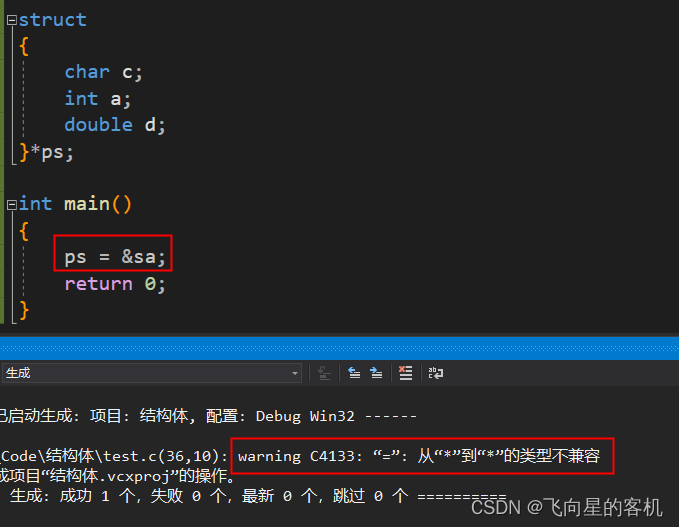
结构体的自引用
我们思考一个问题:在结构中包含一个类型为该结构本身的成员是否可以呢?
比如这样
struct Node
{
int data;
struct Node next;
};
This is absolutely impossible;
If we include in a struct a member of type the struct itself,So what is the size of this structure type I ask for at this time??
首先在 Node 里面有个 int 类型,然后还有个 struct Node next 类型;
那么在 struct Node next 里面还有个 int 类型,和 struct Node next 类型…And so on will form a wireless loop;
So we only need to store the address of a structure type.
struct Node
{
int data;
struct Node* next;
};
此时,我们创建的每个 Node 节点里面,can save a value,another address;
通过这个地址,can be found by next 指向的下一个节点;
At this time the size of the structure can be identified:int 类型 4 个字节、指针类型 4 / 8 字节;
结构体变量的定义和初始化
有了结构体类型,那如何定义变量,其实很简单
struct Point
{
int x;
int y;
}p1; //声明类型的同时定义变量p1
struct Point p2; //定义结构体变量p2
//初始化:定义变量的同时赋初值.
struct Point p3 = {
1, 2 };
What if it's a little more complicated?
#include <stdio.h>
struct Node
{
int data;
struct Node* next;
};
struct Stu
{
char name[20];
char sex[5];
int age;
int hight;
};
int main()
{
struct Node n1 = {
100, NULL };
struct Stu s1 = {
"张三", "男", 20, 180 };
return 0;
}
上面可以看到,Every time we define the variables of the structure, we have to use struct Node,是不是感觉很麻烦?
那么可以使用 typedefto do it 重命名,At this point, we can create variables and use 重命名
typedef struct
{
int data;
struct Node* next;
}Node;
int main()
{
Node n = {
0 };
return 0;
}
Compile a look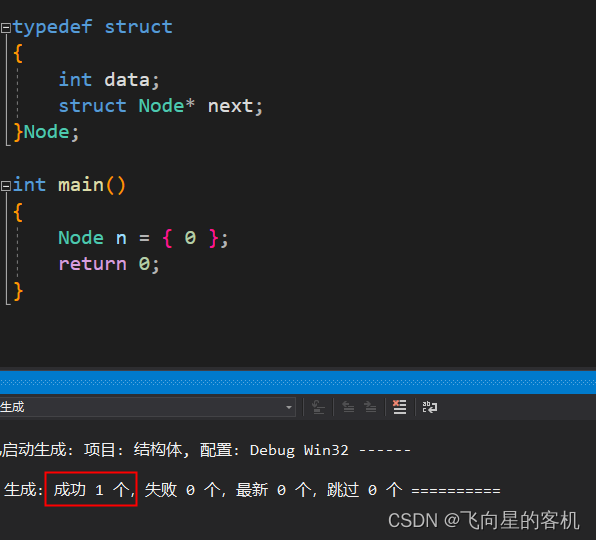
then if the members of the struct are 嵌套 的,So how to initialize structure variables??
#include <stdio.h>
struct Stu
{
char name[20];
char sex[5];
int age;
int hight;
};
struct Data
{
struct Stu s;
char ch;
double d;
};
int main()
{
struct Data d = {
{
"李四", "女", 30, 170 }, "w", 3.14 }; //结构体嵌套初始化
return 0;
}
看一下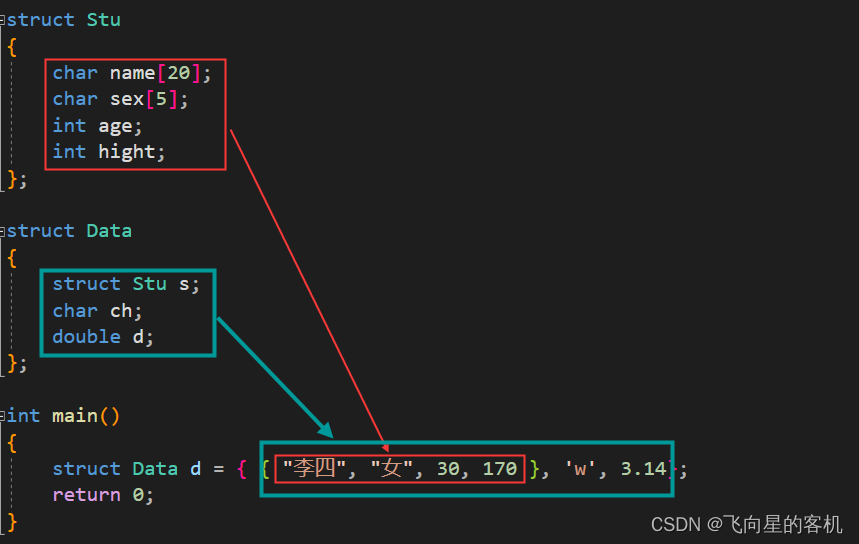
2. 结构体传参
Think about when we pass parameters to the structure,Pass the structure or pass the address??
代码示例一
#include <stdio.h>
struct S
{
int data[1000];
int num;
};
struct S s = {
{
1,2,3,4}, 1000 };
//结构体传参
void print1(struct S s)
{
printf("%d\n", s.num);
}
int main()
{
print1(s); //传结构体
return 0;
}
代码示例二
#include <stdio.h>
struct S
{
int data[1000];
int num;
};
struct S s = {
{
1,2,3,4}, 1000 };
//结构体地址传参
void print2(struct S* ps)
{
printf("%d\n", ps->num);
}
int main()
{
print2(&s); //传地址
return 0;
}
上面的 print1 和 print2 Which function is better??
答案是:首选 print2 函数.
原因:
1、函数传参的时候,参数是需要压栈,会有时间和空间上的系统开销.
2、如果传递一个结构体对象的时候,结构体过大,参数压栈的的系统开销比较大,所以会导致性能的下降.
结论:结构体传参的时候,要传结构体的地址.
3. 结构体内存对齐
关于 结构体的内存对齐 This is a high-frequency test site for interviews,很重要;
代码示例一
First, there is a piece of code below,Analyze the size of this structure type in bytes.?
struct S1
{
char c1;
int i;
char c2;
};
int main()
{
printf("%d\n", sizeof(struct S1));
return 0;
}
第一眼,大家会想到:c1 是 char 类型,占 1 个字节;
i 是 int 类型,占 4 个字节;
c2 是 char 类型,占 1 个字节;
加起来就是 6 个字节,那么究竟是不是呢?运行看一下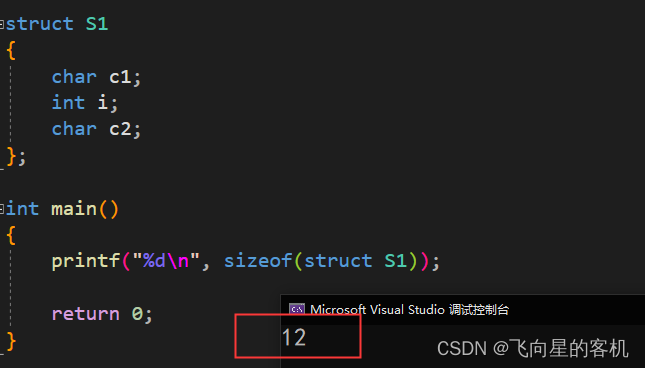
咦?这里为什么是 12 呢?
Here we need to explore,But before that,要学习一个东西,叫 offsetof.
offsetof,是一个 宏,it is used to return:the offset of a member from the start of a structure.
也就是,It can compute a struct member,an offset from the starting position.
用法:
size_t offsetof(structName, memberName);
代码示例
#include <stdio.h>
#include <stddef.h>
struct S1
{
char c1;
int i;
char c2;
};
int main()
{
printf("%d\n", offsetof(struct S1, c1));
printf("%d\n", offsetof(struct S1, i));
printf("%d\n", offsetof(struct S1, c2));
return 0;
}
运行结果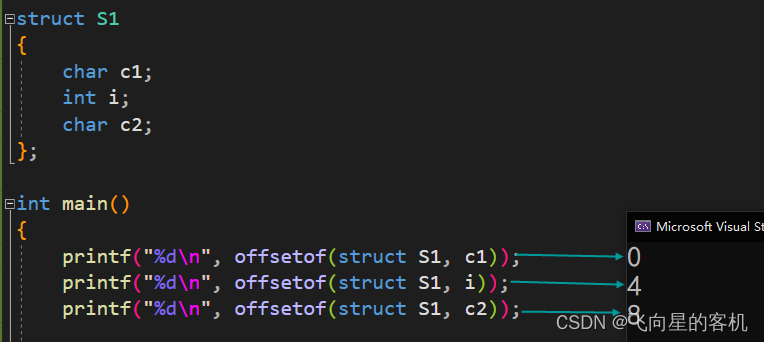
为什么是 0、4、8 呢?
首先,我们创建一个结构体类型 S1,红色箭头 Is the structure of the starting position,从起始位置开始,每个格子代表 1 个字节,The first grid is compared to 起始位置 偏移量是 0;The second grid is compared to 起始位置 偏移量是 1;The third grid is compared to 起始位置 偏移量是 2,以此类推…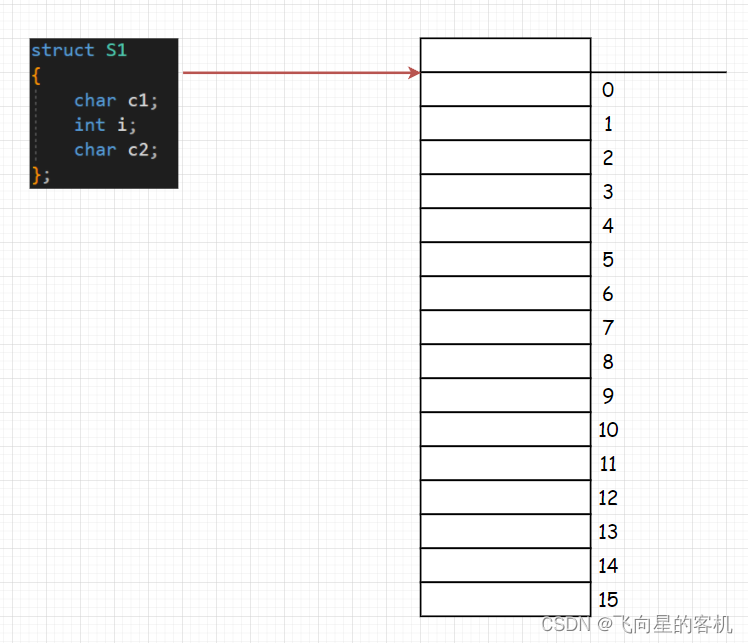
According to the running result of the above code, we can know,c1 相较于 起始位置 偏移量是 0,并且 c1 是 char 类型,占 1 个字节,所以 c1 The memory space occupied by members is as follows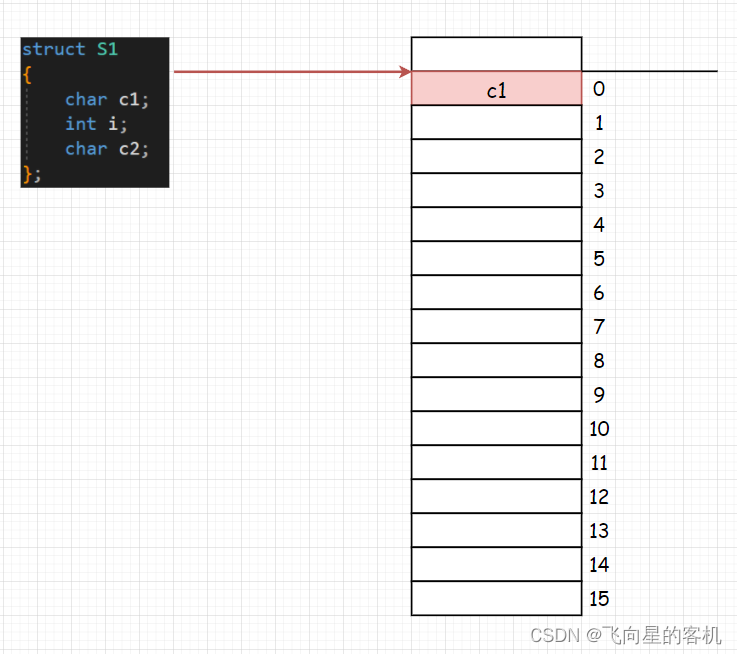
i 相较于 起始位置 偏移量是 4,并且 i 是 int 类型,占 4 个字节,所以 i The memory space occupied by members is as follows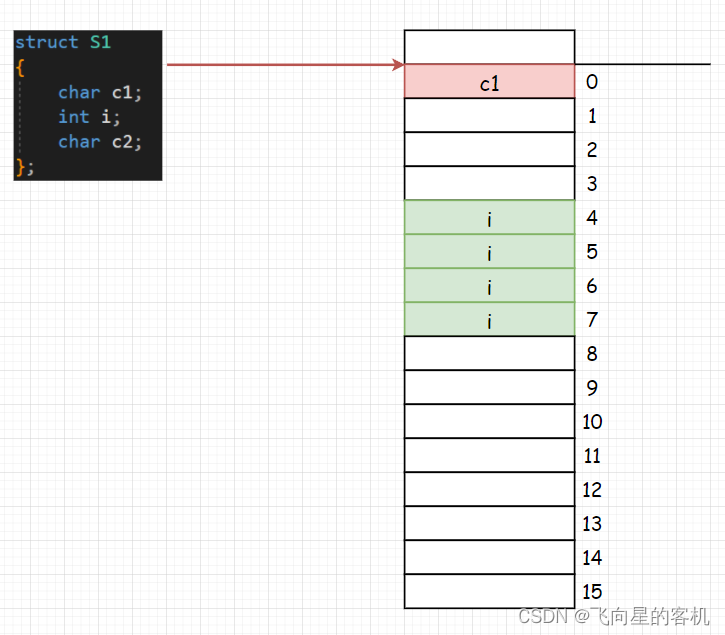
c2 相较于 起始位置 偏移量是 8,并且 c2 也是 char 类型,占 1 个字节,所以 c2 The memory space occupied by members is as follows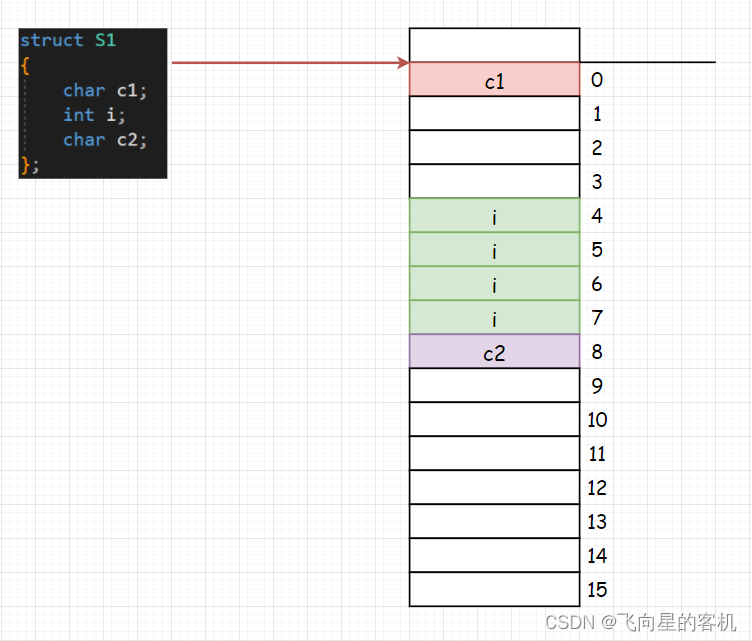
But what we calculated is 12 个字节呀,也就是说,前 3 And after a grid 3 grid is useless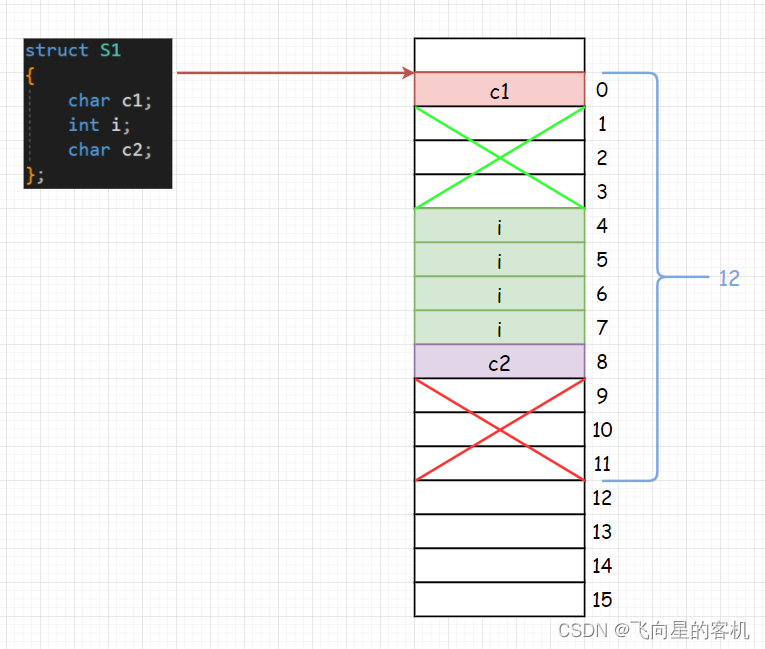
那么为什么呢?Why waste so much space doing this??
这个时候,Introduced to our topic today 结构体内存对齐 !
首先得掌握结构体的对齐规则:
1、结构体的第一个成员,存放在结构体变量开始位置的 0 的偏移量处.
2、从第二个成员开始,都要对齐到对齐数的整数倍的地址处.
对齐数 :成员自身大小和默认对齐数的较小值.
在 VS 环境下,默认的对齐数是 8,S1 中 i The size of the member itself is 4 字节,而 VS The default alignment number provided by the editor is 8,Take both of it 最小值 为对齐数,所以 i 的对齐数就是 4;
那么 i 就要对齐到 4 的整数倍的地址处,所以 i is placed at an offset of 4 at multiple addresses,换句话说 4 Integer multiples include 4 (It might be a little bit twisty here)
c2 的自身大小是 1,And the default alignment number is 8,Take both of it 最小值 为对齐数,所以 c2 的对齐数就是 1;
and any address is 1 的倍数,So put the offset as 8 the grid
3、结构体的总大小,必须是最大对齐数的整数倍
最大对齐数 :是指所有成员的对齐数中最大的那个.
c1 :自身大小是 1,VS 默认对齐数是 8,取较小值,所以对齐数是 1;
i :自身大小是 4,VS 默认对齐数是 8,取较小值,所以对齐数是 4;
c2 :自身大小是 1,VS 默认对齐数是 8,取较小值,所以对齐数是 1;
所以 S1 结构体的总大小必须是 4 的倍数,At this point, after we align the 9 byte grid,9 不是 4 multiples of!
Then keep going down,浪费 3 个空间,The total size 12 个字节了(4 的 3 倍)
注意:Linux环境没有默认对齐数,The alignment number is the size of itself
代码示例二
We have basically mastered the rules of alignment,Then change the position of the above code slightly
代码示例
#include <stdio.h>
struct S1
{
char c1;
int i;
char c2;
};
struct S2
{
char c1;
char c2;
int i;
};
int main()
{
printf("%d\n", sizeof(struct S2));
return 0;
}
运行结果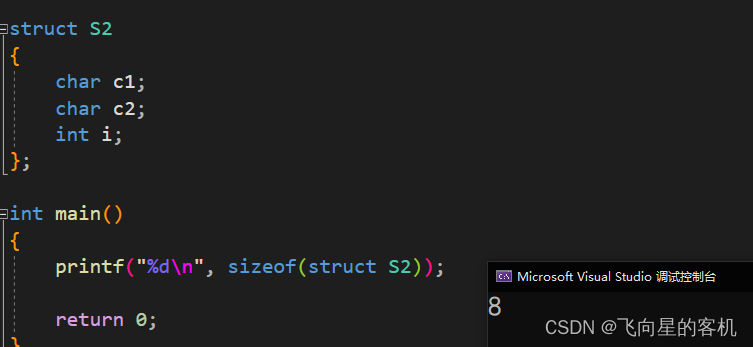
So let's do the math again S2 How are they aligned in memory?
First the first member of the struct is always placed 0 偏移处,那么 c1 就放在 0 偏移处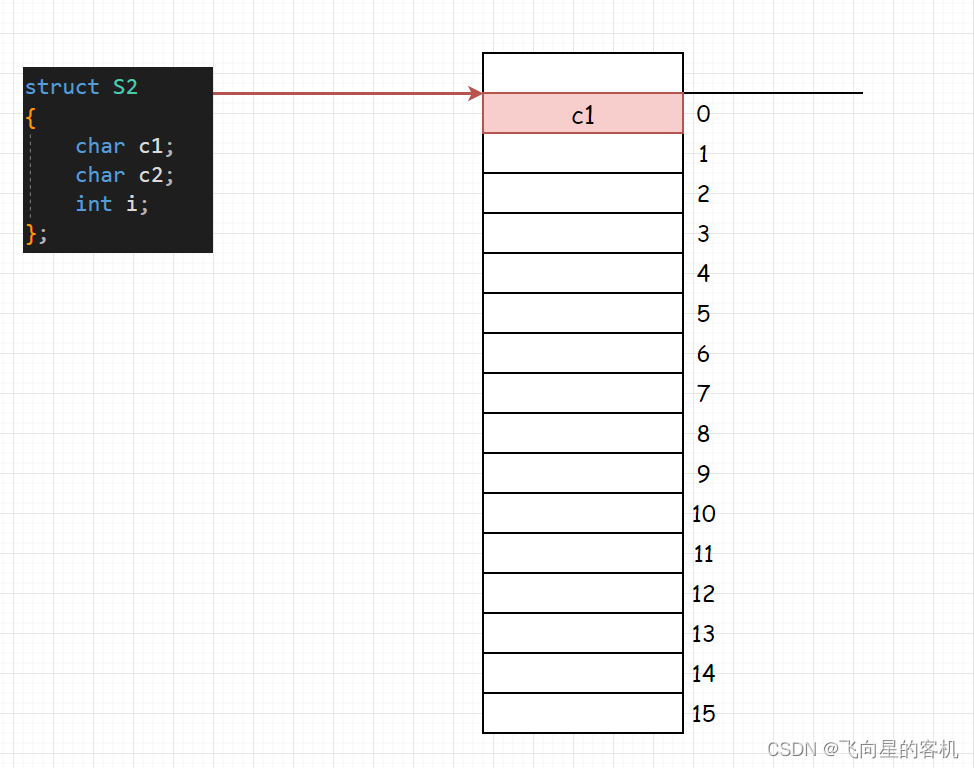
第二个成员 c2 自身大小是 1,默认对齐数是 8,取较小值,所以对齐数是 1;
and any address is 1 的倍数,So put the offset as 1 the grid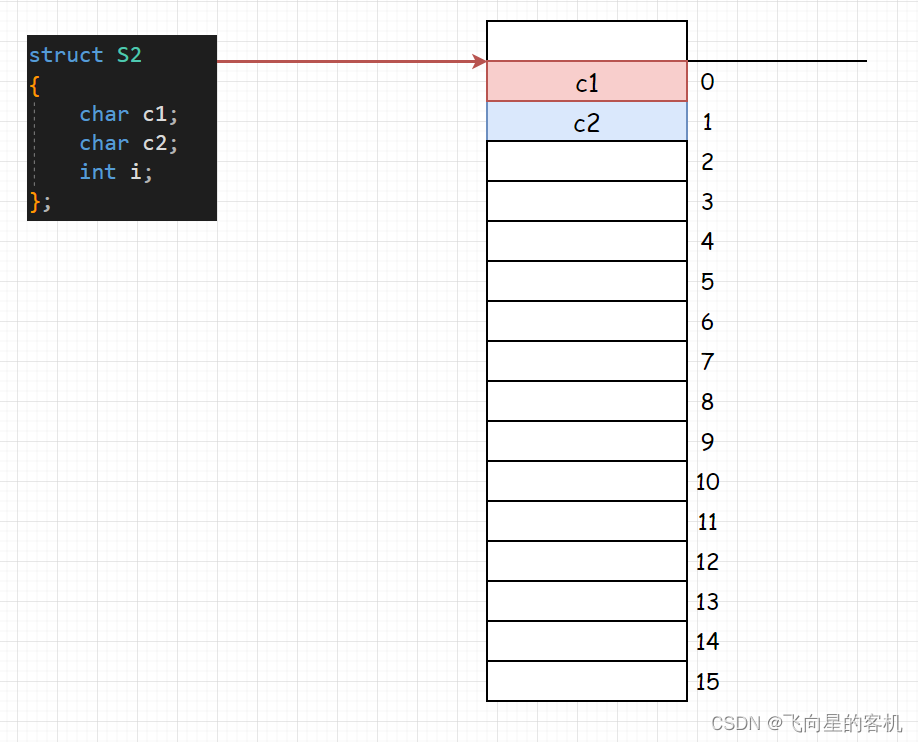
第三个成员 i 自身大小是 4,默认对齐数是 8,取较小值,所以对齐数是 4;
Then look down 4 的倍数,4 的 1 倍是 4,所以 i 对齐到偏移量为 4 的地址处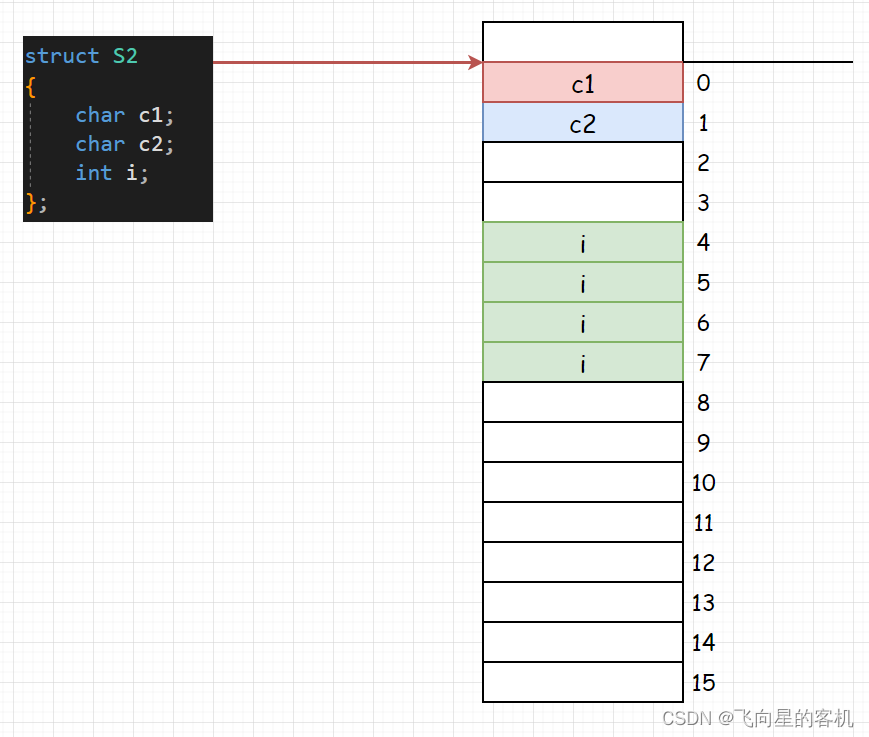
结构体的总大小,必须是最大对齐数的整数倍
c1 :自身大小是 1,VS 默认对齐数是 8,取较小值,所以对齐数是 1;
c2 :自身大小是 1,VS 默认对齐数是 8,取较小值,所以对齐数是 1;
i :自身大小是 4,VS 默认对齐数是 8,取较小值,所以对齐数是 4;
所以 S2 结构体最大对齐数是 4 ,then the total size must be 4 的倍数,At this point, after we align the 8 byte grid,8 是 4 的倍数;
所以结构体总大小为 8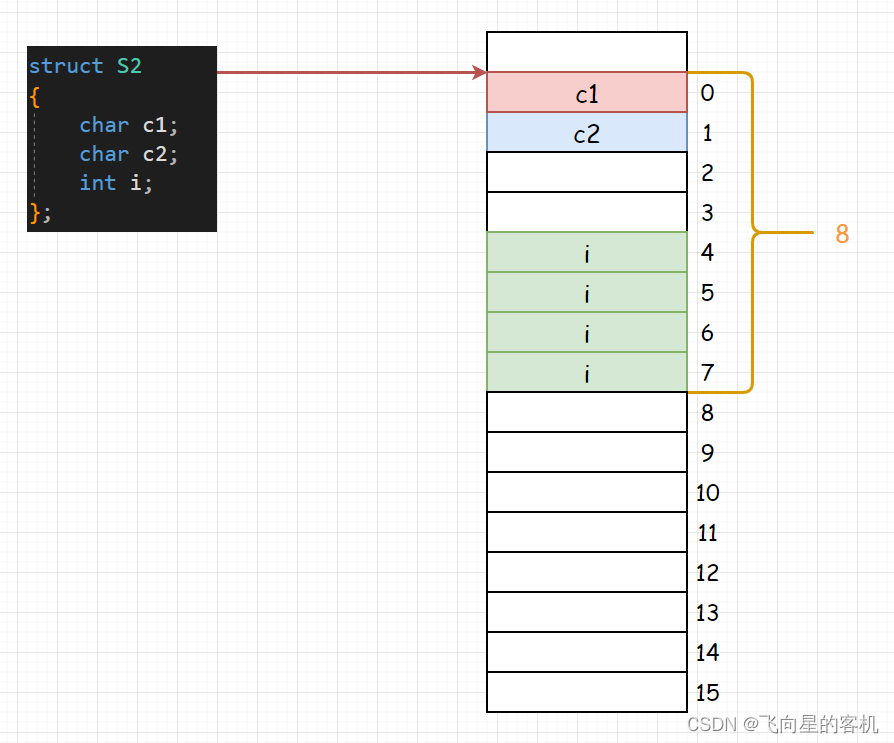
代码示例三
我们再来看一组代码
代码示例
#include <stdio.h>
struct S3
{
char c1;
char c2;
int i;
};
int main()
{
struct S3 s;
printf("%d\n", sizeof(struct S3));
return 0;
}
This time we are drawing first,Check after drawing
First the first member of the struct is always placed 0 偏移处,那么 d 就放在 0 偏移处;
d 是 double 类型,占 8 个字节,所以从 0 偏移处开始,put down 8 个字节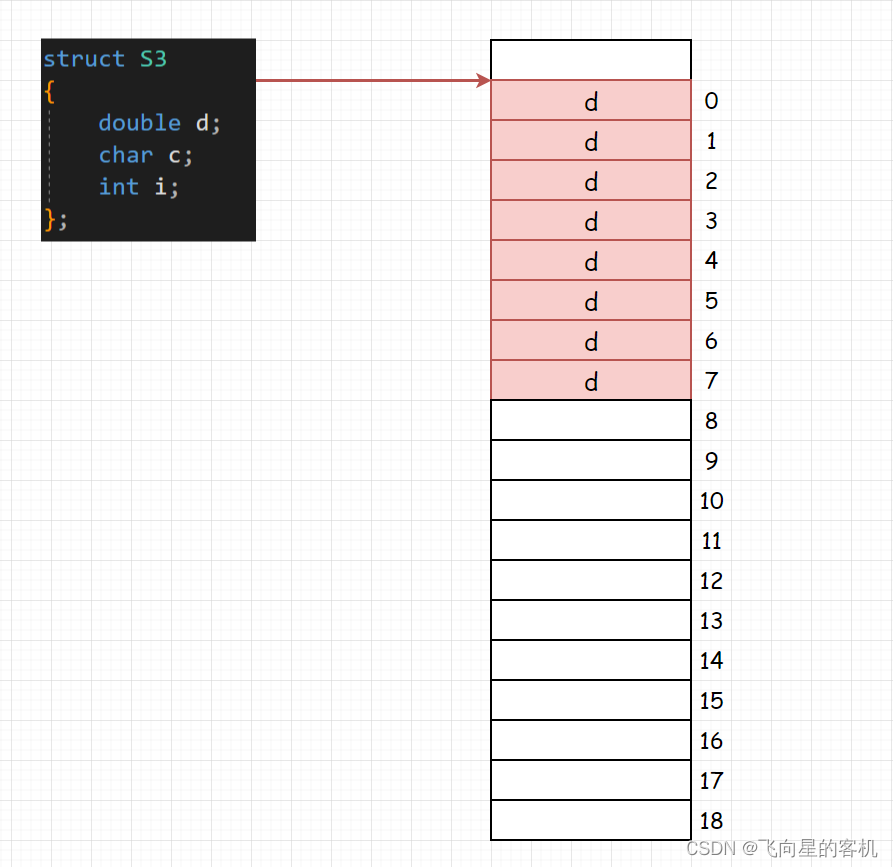
第二个成员 c2 自身大小是 1,默认对齐数是 8,取较小值,所以对齐数是 1;
and any address is 1 的倍数,So put the offset as 8 the grid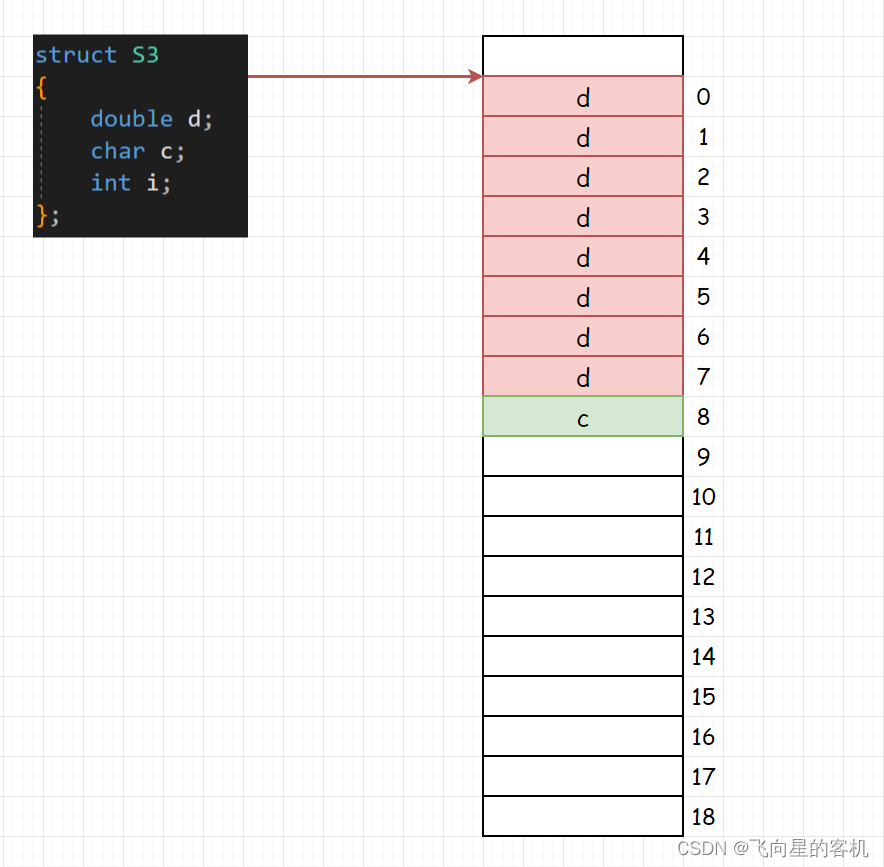
第三个成员 i 自身大小是 4,默认对齐数是 8,取较小值,所以对齐数是 4;
Then look down 4 的倍数,4 的 3 倍是 12,所以 i put it at an offset of 12 的地址处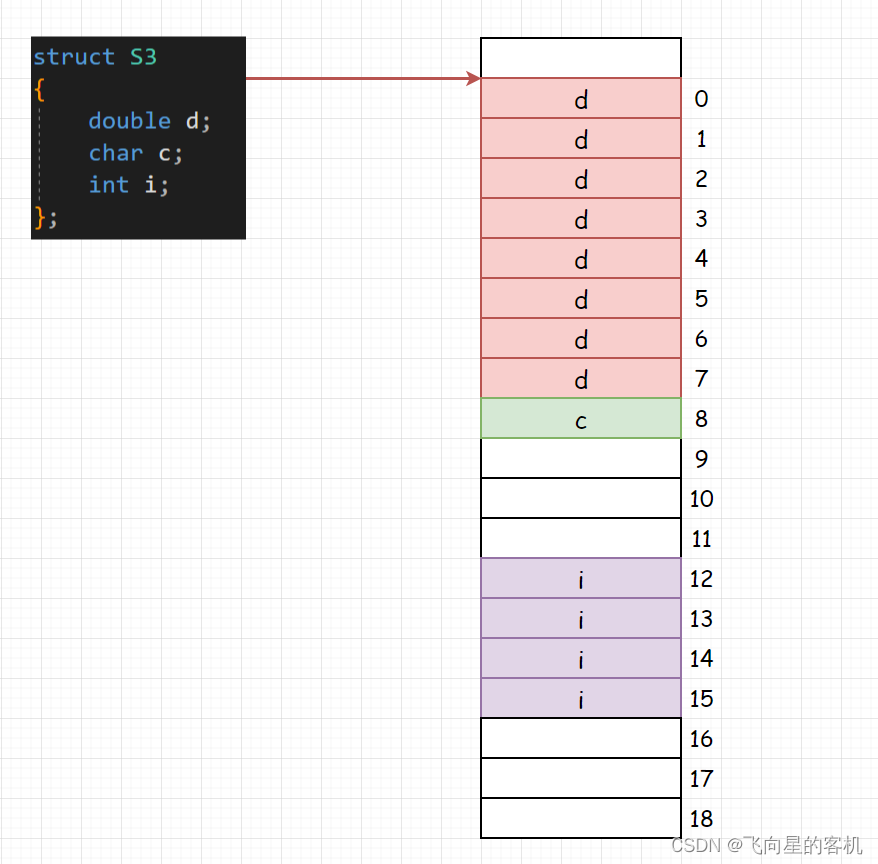
结构体的总大小,必须是最大对齐数的整数倍
d :自身大小是 8,VS 默认对齐数是 8,取较小值,所以对齐数是 8;
c :自身大小是 1,VS 默认对齐数是 8,取较小值,所以对齐数是 1;
i :自身大小是 4,VS 默认对齐数是 8,取较小值,所以对齐数是 4;
所以 S3 结构体最大对齐数是 8 ,then the total size must be 8 的倍数,At this point, after we align the 16 byte grid,16 是 8 的倍数;
所以结构体总大小为 16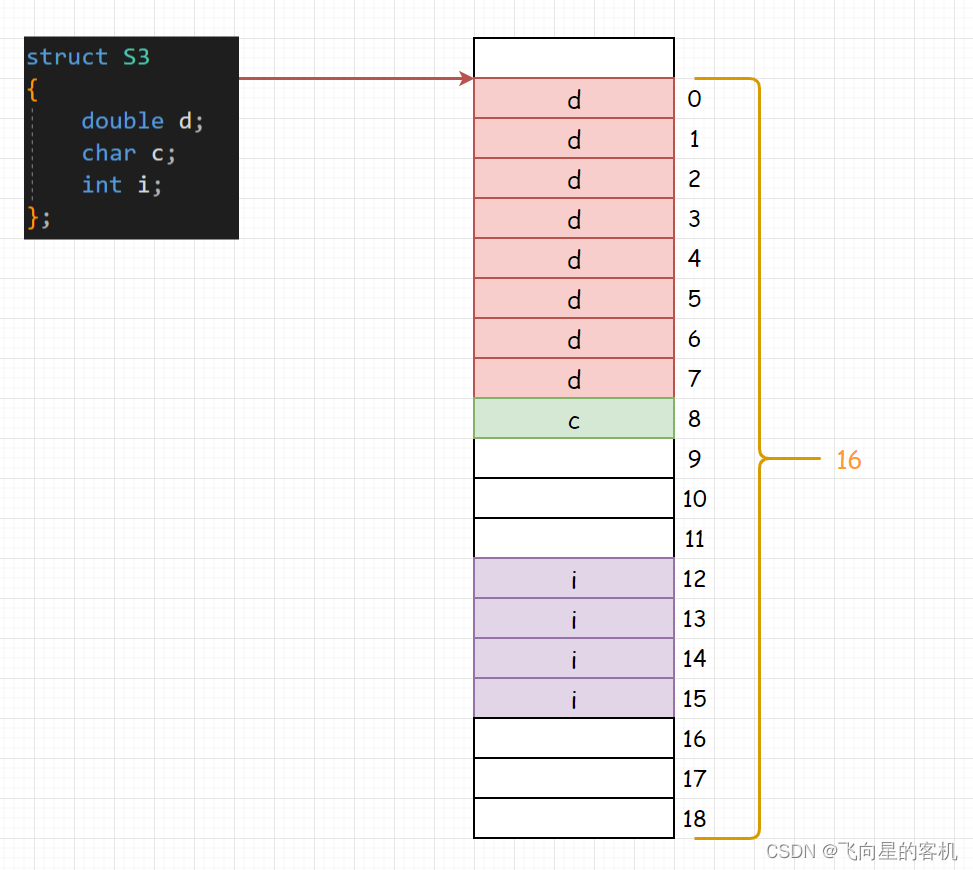
运行结果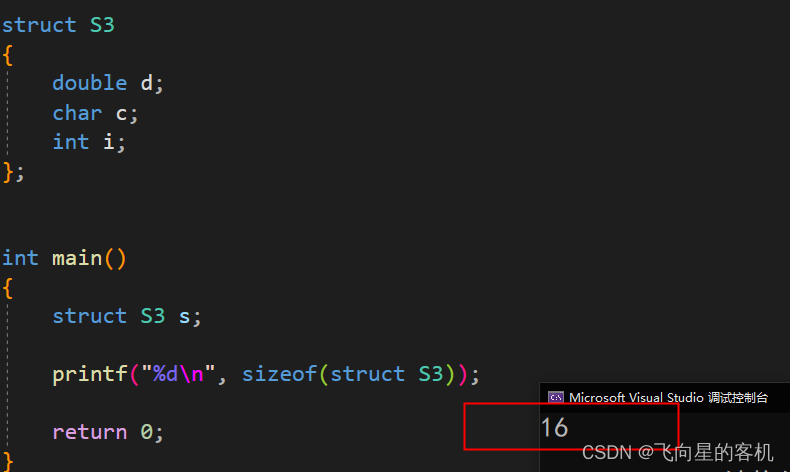
代码示例四
Now that we have learned how to align structure memory,So think about how nested structure alignment?
代码示例
#include <stdio.h>
struct S3
{
double d;
char c;
int i;
};
struct S4
{
char c1;
struct S3 s3;
double d;
};
int main()
{
struct S4 s;
printf("%d\n", sizeof(struct S4));
return 0;
}
我们还是先画图,Check after drawing
First the first member of the struct is always placed 0 偏移处,那么 c 就放在 0 偏移处;
c 是 char 类型,占 1 个字节,所以从 0 偏移处开始,put down 1 个字节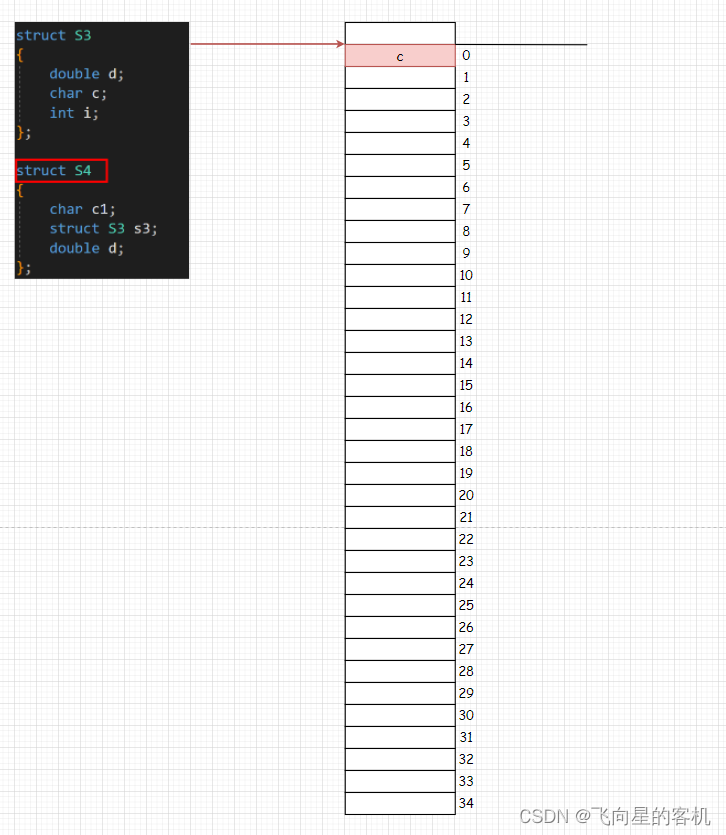
At this point the second member of structure,So that leads us to our fourth rule:
4、 如果嵌套了结构体的情况,嵌套的结构体对齐到自己的最大对齐数的整数倍处,结构体的整
体大小就是所有最大对齐数(含嵌套结构体的对齐数)的整数倍.
第二个成员 s3 ,Its maximum number of alignments is 8,那么也就是说 s3 要对齐到 8 的整数倍处;
因为 8 的 1 倍就是 8,此时 8 The grid at the address is not occupied,So put the offset as 8 the grid
s3 We just calculated 16 个字节,所以从偏移量 8 The grid starts,put down 16 个字节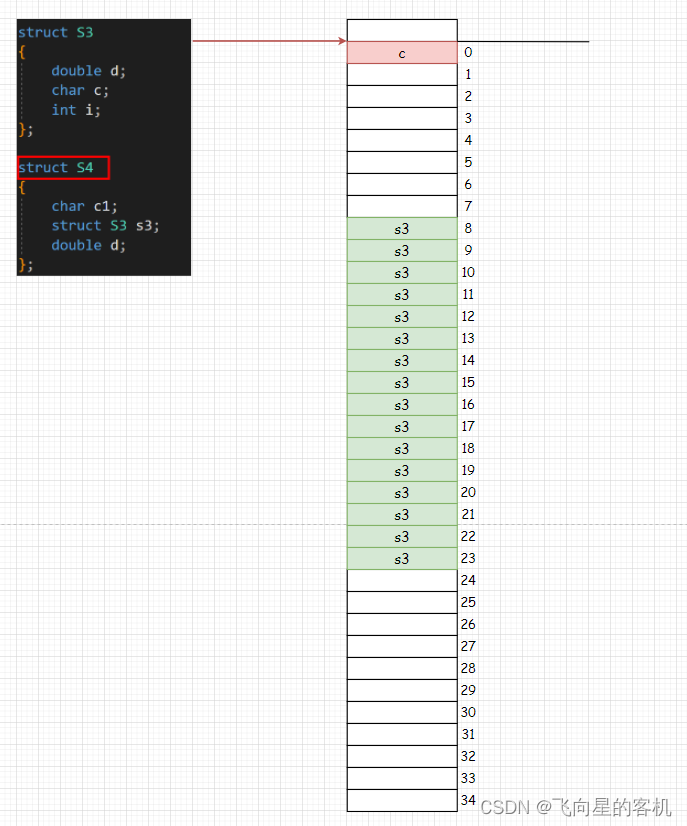
第三个成员 d 自身大小是 8,默认对齐数是 8,所以对齐数是 4;
Then look down 8 的倍数,8 的 3 倍是 24,所以 d put it at an offset of 24 的地址处;
所以从偏移量 24 The grid starts,put down 8 个字节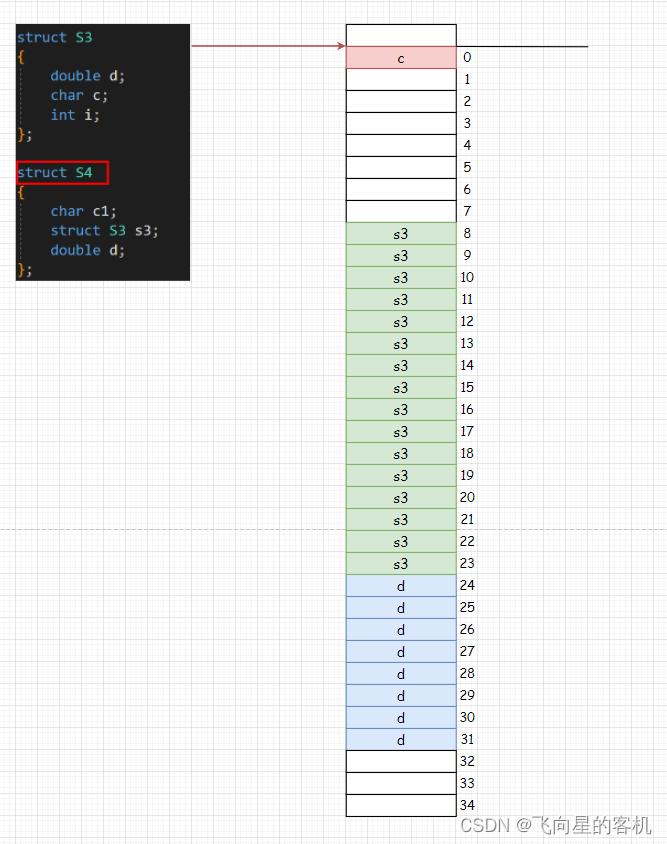
结构体的总大小,必须是最大对齐数的整数倍
c :自身大小是 1,VS 默认对齐数是 8,取较小值,所以对齐数是 1;
s3 :是嵌套结构体,Its overall size is that all the maximum alignments are 8,VS 默认对齐数是 8,所以对齐数是 8;
d :自身大小是 8,VS 默认对齐数是 8,所以对齐数是 8;
所以 S4 结构体最大对齐数是 8 ,then the total size must be 8 的倍数,At this point, after we align the 32 byte grid,32 是 8 的倍数;
所以结构体总大小为 32(0~31,就是32个字节)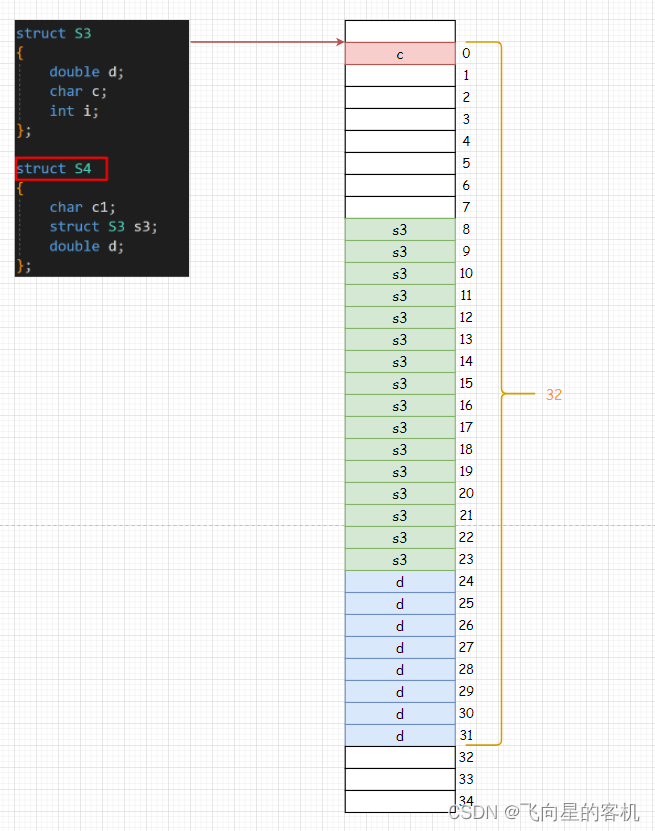
运行结果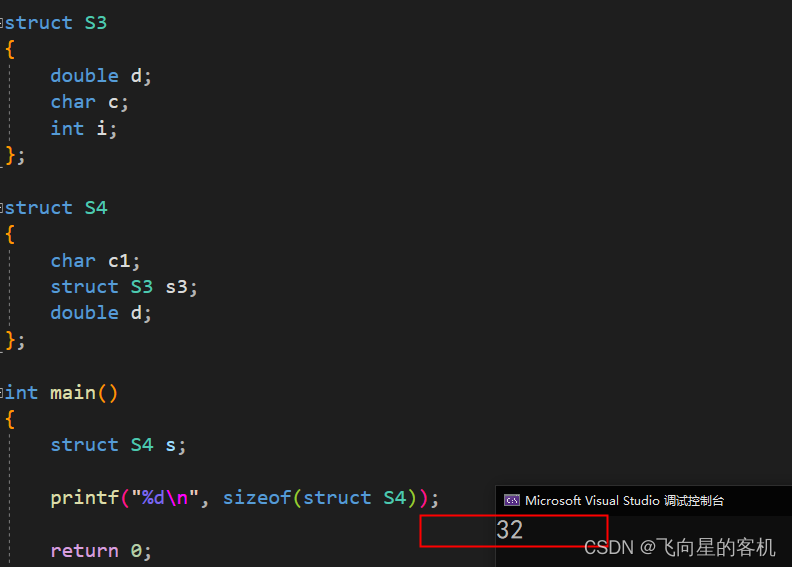
4. 为什么存在内存对齐
- 平台原因(移植原因):
不是所有的硬件平台都能访问任意地址上的任意数据的;
某些硬件平台只能在某些地址处取某些特定类型的数据,否则抛出硬件异常.
- 性能原因:
数据结构(尤其是栈)应该尽可能地在自然边界上对齐.
原因在于,为了访问未对齐的内存,处理器需要作两次内存访问;而对齐的内存访问仅需要一次访问.
总体来说:结构体的内存对齐是拿空间来换取时间的做法.
那在设计结构体的时候,我们既要满足对齐,又要节省空间,如何做到呢?
让占用空间小的成员尽量集中在一起.
代码示例
#include <stdio.h>
struct S1
{
char c1;
int i;
char c2;
};
struct S2
{
char c1;
char c2;
int i;
};
int main()
{
struct S1 s1;
struct S2 s2;
printf("%d\n", sizeof(struct S1));
printf("%d\n", sizeof(struct S2));
return 0;
}
运行结果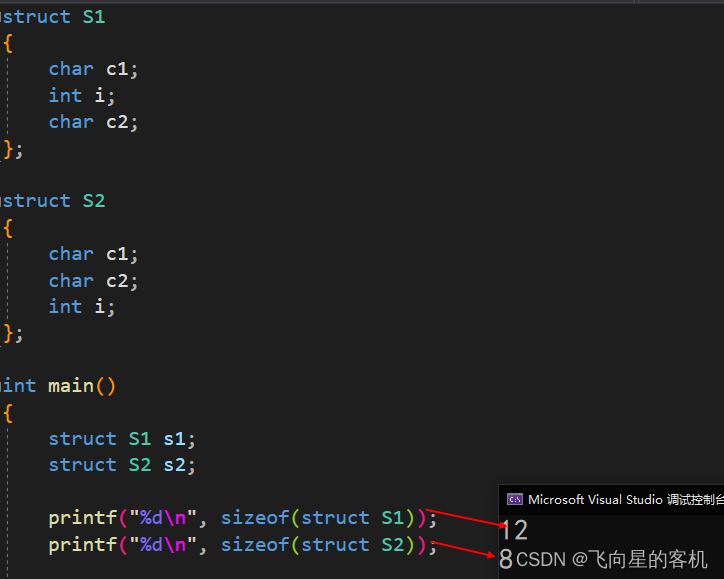
S1 和 S2 类型的成员一模一样,但是 S1 和 S2 所占空间的大小有了一些区别.
所以让占用空间小的成员尽量集中在一起.
5. 修改默认对齐数
之前我们见过了 #pragma 这个预处理指令,这里我们再次使用,可以改变我们的默认对齐数.
代码示例
#pragma pack(1) //设置默认对齐数为 1
struct S1
{
char c1;
int i;
char c2;
};
#pragma pack() //取消设置的默认对齐数,还原为默认
struct S2 //不设置,默认就是 8
{
char c1;
int i;
char c2;
};
int main()
{
struct S1 s1;
struct S2 s2;
printf("%d\n", sizeof(struct S1));
printf("%d\n", sizeof(struct S2));
return 0;
}
运行结果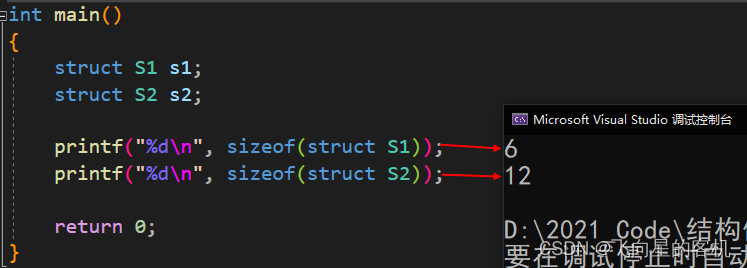
结论:结构在对齐方式不合适的时候,我么可以自己更改默认对齐数.
边栏推荐
- In the anaconda Promat interface, import torch is passed, and the error is reported in the jupyter notebook (only provide ideas and understanding!)
- Antdesign a-select 下拉框超出长度换行显示
- 高效使用数码相机的诀窍
- Stored procedure writing experience and optimization measures
- TRACE32——Go.direct
- 数据库——概述
- 【结构体内功修炼】枚举和联合的奥秘(三)
- An IP conflict is reported after installing the software on a dedicated computer terminal
- iptables实现网络限制下ntp自定义端口同步时间
- 彩绘漂亮MM集
猜你喜欢
随机推荐
D2--FPGA SPI接口通信2022-08-03
Invalid operator for data type.The operator is add and the type is text.
JVM运行流程,运行时数据区,类加载,垃圾回收,JMM解析
Adb 授权过程分析
In the anaconda Promat interface, import torch is passed, and the error is reported in the jupyter notebook (only provide ideas and understanding!)
2022.8.2 模拟赛
RedisTemplate: 报错template not initialized; call afterPropertiesSet() before using it
剑指Offer面试题解总结1-10
Support touch screen slider carousel plugin
An IP conflict is reported after installing the software on a dedicated computer terminal
php向mysql写入数据失败
Qt writes custom controls: one of the text spotlight effects
693. 行程排序
moment的使用
Does Libpq support read-write separation configuration?
Unity—物理引擎+“武器模块”
Flink Learning 10: Use idea to write WordCount and package and run
MVCC of Google's Fragmented Notes (Draft)
Qt编写自定义控件:文字聚光灯效果之一
环网冗余式CAN/光纤转换器 CAN总线转光纤转换器中继集线器hub光端机


